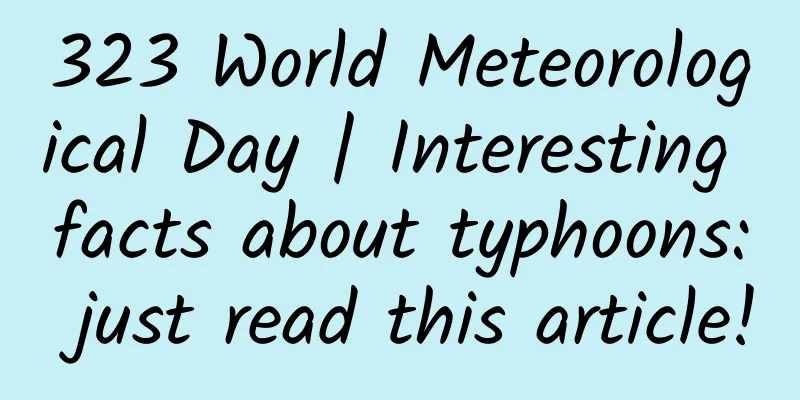323 World Meteorological Day | Interesting facts about typhoons: just read this article!

|
In a few months, the typhoon season will come one after another. Although it can wash away some of the summer heat, it is inevitably accompanied by heavy rainfall, which may cause damage to people's lives and property. How are these typhoons that people love and hate formed? In which areas are they mainly distributed? Where do those strange names of typhoons come from? In order to solve these problems, we conducted an exclusive interview with Ms. Tang Danling, an "expert in the study of the marine ecological and environmental effects of typhoons", director of the Guangdong Provincial Marine Ecological and Environmental Remote Sensing Center and professor of the Guangzhou Marine Laboratory. Is there any scientific basis for the “butterfly effect”? There is a saying circulating on the Internet: A butterfly in the tropical rainforest of the Amazon River Basin in South America, just by flapping its wings a few times, can cause a tornado in Texas, USA two weeks later. Could it be that typhoons are also caused by the "butterfly effect"? In fact, the "butterfly effect" is a phenomenon in chaos theory, which refers to the fact that small initial changes in a complex system may trigger large-scale, unpredictable consequences. Image source: VEER Gallery In meteorology, changes in meteorological conditions within a small area (such as a butterfly flapping its wings over the Pacific Ocean) can cause tiny changes in the initial field of the global atmospheric system. These tiny impacts may gradually expand through the nonlinear amplification effect of the atmospheric system and eventually lead to larger-scale atmospheric changes, such as the formation of cyclones, storms or typhoons. Although the butterfly effect emphasizes the complexity and uncertainty of the atmosphere and climate system, it does not literally mean "a butterfly flapping its wings causes a typhoon." The formation and path of a typhoon are affected by a variety of complex factors and are the result of multi-level interactions between the atmosphere, ocean, and the earth's surface. So what are the specific reasons for the formation of a typhoon? Distribution and causes of typhoons High temperature and high humidity are the primary conditions for the formation of typhoons, so typhoons are more common in tropical and subtropical waters, mainly concentrated in certain areas of the Pacific Ocean, Indian Ocean and Atlantic Ocean. Typhoons in different regions are also called differently. For example, they are called "typhoons" in the northwest Pacific region; "hurricanes" in the North Atlantic region; and "cyclones" in the Indian Ocean region. These storms appear under different names and have their own characteristics, but they are essentially strong tropical cyclones. For my country, most typhoons begin in the southern Pacific Ocean with clouds and thunderstorms as their prototype. When the sea temperature reaches 26 degrees Celsius (79 degrees Fahrenheit) or above, it can provide sufficient heat for the formation of typhoons. Under the heating of solar radiation, the warm seawater evaporates to form water vapor, which rises to form a low-pressure area. When the temperature and humidity of this low-pressure area reach a certain level, clouds will form. As more and more water vapor condenses and "hugs together", the volume of the cloud gradually increases, forming the initial form of the typhoon. Image source: VEER Gallery Affected by the rotation of the earth and the Coriolis force, the rotation of the low-pressure area gradually intensifies. In the northern hemisphere, the cloud cluster will rotate clockwise to the right (the opposite is true in the southern hemisphere), which is an important feature of a typhoon. This rotation will cause the air flow inside the typhoon to continue to accelerate, thereby increasing the intensity of the typhoon. As a typhoon develops, its diameter will gradually expand, and the air in the center will rise higher and become colder. When it rises to a certain height, water vapor will condense into ice crystals, which will form an eye-like shape around the center of the typhoon, called the "eye wall" or "eye wall", where the storm occurs most violently . The thunderstorm belt circulating outward from the eye is called the "spiral rain belt". Image source: VEER Gallery The little-known typhoon naming method From tropical depression to typhoon to super typhoon, a "cyclone" also has different levels, and the typhoon classification standards used in different regions of the world are different. According to national standards, the China Meteorological Administration classifies tropical cyclones into six levels from small to large, based on the maximum sustained wind speed near the center of the tropical cyclone: tropical depression, tropical storm, severe tropical storm, typhoon, severe typhoon, and super typhoon. Image source: China Meteorological Administration On August 16, 2004, the China Meteorological Administration issued the "Trial Measures for Issuing Early Warning Signals for Sudden Meteorological Disasters", which divided typhoon warning signals into four levels: blue, yellow, orange and red. When a typhoon red warning is issued, the city's emergency response measures of suspending classes, work, production, operations and business (referred to as the five suspensions) will be activated. People should actively prepare for typhoons and avoid going out. After figuring out the classification of typhoons, I believe many people will still be curious about how such strange typhoon names as "Mangkhut", "Haiyan" and "Dusurui" came from. In the past, some typhoons that landed were named after animals, some were named after plants, and some were named after people. Some sounded gentle and harmless, while others sounded fierce and evil, making people avoid them. The naming of typhoons is a science, and there is a set of careful considerations behind each seemingly random name. In general, different regions have different naming systems. In 1951, the National Hurricane Center of the United States took the lead in naming hurricanes, which was soon adopted by other countries. China also formulated its own typhoon naming standards in 1963, stipulating that typhoons in the East China Sea, South China Sea, Taiwan Strait and northeastern South China Sea are named after male or female names or Hong Kong place names every year. This way of naming people and places is widely used because of its high recognition and cultural differences between different regions. The 30th annual meeting of the World Meteorological Organization's Typhoon Committee, held in Hong Kong from November 25 to December 1, 1997, decided that tropical cyclones in the northwest Pacific and the South China Sea would be named with Asian-style names, and decided to use a new naming method and establish a new naming table starting from January 1, 2000. There are 140 names in the typhoon naming list, and 14 members of the typhoon committee each provide 10 names based on their preferences or characteristics. **Due to the large number of countries and regions, each place has a different style, and the names are also varied. However, all the names included in the naming library must adhere to the following principles: Each name should not exceed 9 letters, and the Chinese name should consist of 2-3 Chinese characters. It should be easy to spread in the media and easy to pronounce. It has no negative meaning in the language of the members and will not cause any trouble to the members; It cannot be the name of a commercial organization; It should be approved by all members. If any member objects, it cannot be used to name a typhoon. Since 2000, typhoons are named in order every year, year after year, in a cycle. Since there are generally 20-30 typhoons a year, the 140 names are used every 5-6 years. In order to distinguish them, we will also add a four-digit number after each name: the first two digits represent the year, and the last two digits represent the order in which the tropical storms were generated in that year. For example, the typhoon "Sura" that landed in Guangdong some time ago has an international code of "2309", 23 represents the year 2023, and 09 represents that Sura is the ninth storm generated in 2023. The name "Sura" was provided by Vietnam, meaning the saola, a rare and precious animal in Vietnam. This is the fourth time that the name has been used as a typhoon name. The name of this typhoon "Sam-ba" was provided by Macau, China, and was inspired by the Ruins of St. Paul's, a tourist attraction in Macau. However, there are also taboos in typhoon naming. If a typhoon is severely destructive and causes particularly serious disasters or casualties, members of the Typhoon Committee can propose to remove the name from the typhoon naming list , or "permanently name" the typhoon. The vacant typhoon name caused by the removal will be replaced by a new name proposed by the Typhoon Committee of the corresponding nominating country or region. Since the typhoon naming list was used in 2000, as of this year, 59 typhoons have been removed from the list. The purpose of the typhoon naming system is to make it easier to identify and communicate information about typhoons, avoid confusion with other important weather phenomena, and increase public awareness of dangerous meteorological events and facilitate timely prevention and response measures. Why do some typhoons always “unpredictably”? Every time I receive a weather forecast, I prepare for the arrival of a typhoon and close the doors and windows tightly. In the end, I often only get a drizzle. When I turn on my phone, I find that the typhoon has turned around and headed to a neighboring country! Why can a typhoon turn at a right angle? Is there some mysterious force controlling the direction of the typhoon? In fact, the change of path or direction of a typhoon is a common and complex meteorological phenomenon, which is usually the result of the interaction of multiple factors. 2023 Typhoon No. 6 "Kanu" path forecast map Source: Central Meteorological Observatory The following are some of the main reasons that may cause the typhoon to turn: Atmospheric high and low pressure systems: High and low pressure systems in the atmosphere can affect the path of a typhoon. Usually, a typhoon will move forward along the edge of an atmospheric high pressure system. If a high pressure system is strong enough in front of a typhoon, it may push the typhoon to a more northerly or southerly path, causing the typhoon to turn; Subtropical high pressure belt: In the subtropical region, there is usually an area of high pressure called the subtropical high pressure belt, which can guide typhoons to a path closer to the equator. This can also cause typhoons to turn; Topography: Topographic features such as mountains, islands, and coastlines can significantly affect the path of a typhoon. When a typhoon approaches these features, the topography can distort the airflow, causing the typhoon to change direction. A typhoon may rise along a mountain range and then flow downstream, or it may be blocked by a continent and change direction; Interaction and merging between typhoons: When multiple typhoons or cyclonic systems approach, the interaction between them can cause path changes. Sometimes, two cyclonic systems can merge into a larger system, causing path changes. Monsoon and regional strong winds: Seasonal changes in the monsoon wind system can affect the path of a typhoon. The strength and direction of the monsoon wind system vary from season to season, which may cause a typhoon to change direction when the monsoon wind direction changes. It should be emphasized that the path of each typhoon is unique due to a variety of factors. Meteorologists use complex numerical models to predict the path of typhoons, but typhoon path prediction remains challenging due to various uncertainties. For example, when Typhoon Tali hit, the media live broadcast showed three predicted paths, namely data from China, Japan and the United States. Although the three paths were in the same general direction, the deflection angles and the areas they passed through were quite different. This is because different countries and meteorological agencies use different meteorological models and data sets to predict typhoons. In addition, different understandings and analysis methods of factors affecting typhoon paths may also lead to differences in predicted paths. Here are some of the main reasons why the forecast paths may differ: Differences in meteorological models: Different countries and meteorological agencies use different numerical meteorological models to predict typhoon paths. These models may differ in complex atmospheric dynamics and physical processes, thus leading to changes in path predictions; Typhoon update frequency and timeliness: Typhoon path prediction is a dynamic process, and meteorological agencies will continuously update their forecasts, especially when the typhoon approaches land. Meteorological agencies in different countries and regions may have different forecast update frequencies and timeliness, which may also lead to different path predictions; Differences in data analysis methods: Different meteorological agencies may use different analysis methods and techniques to interpret and process meteorological data, which may lead to different interpretations and predictions of typhoon paths; Differences in meteorological data sources: Typhoon path prediction relies on observational data, including satellite observations, weather radar and buoy data, etc. Different countries and regions may use different data sources and different data analysis methods, which may lead to different prediction results; Influence of local meteorological conditions: The typhoon path is also affected by local meteorological conditions, including the location and intensity of high-pressure and low-pressure systems. These conditions can change in a short period of time and have an important impact on the typhoon path. In summary, meteorological agencies in different countries and regions may issue different typhoon path forecasts to provide multiple possibilities so that the public and decision makers can better understand potential risks and take appropriate precautions. In one sentence, "the predicted path is for reference only, everything is subject to actual conditions." The final path is usually determined by the actual movement of the typhoon, so it is very important to pay attention to the latest information and alerts issued by the local meteorological department. How accurate are typhoon forecasts currently? In order to improve prediction accuracy and response capabilities, China has taken a number of measures in typhoon warning and monitoring, which can be divided into the following aspects: Weather radar and satellite monitoring: The China Meteorological Administration (CMA) uses modern technologies such as weather radar and satellites to monitor the location, path and intensity of typhoons. These monitoring devices can provide real-time data to help the meteorological department track and predict the dynamics of typhoons more accurately; Typhoon Coordinated Observation Network: In September this year, the China Meteorological Administration carried out effective mobile observation operations based on large drones for the first time for typhoons in the South China Sea, and formed a three-dimensional coordinated observation network under the background of multiple typhoons with Beidou navigation flat drift sounding, ground-based remote sensing vertical observation system, "Sun Yat-sen University" scientific research ship and other detection means; Numerical meteorological models: China's meteorological department uses advanced numerical meteorological models to predict the path and intensity of typhoons. These models are based on atmospheric and ocean data and use numerical calculations to simulate and predict the future movement and development trend of typhoons. At present, there are numerical preparatory models such as the assimilation forecast model based on the 9-kilometer resolution South China Sea Typhoon Numerical Forecast System (CMA-TRAMS) model. We will further create a multi-factor, multi-angle, and multi-directional mobile observation business system, and gradually establish and improve a mobile, efficient, coordinated, integrated, and scientifically arranged intelligent mobile observation network; Regular warnings: CMA regularly issues typhoon warnings, including typhoon paths, intensities, and possible impacts on the region. These warnings can be used to inform the public and government departments in a timely manner so that they can take necessary preventive measures; International cooperation: China actively participates in typhoon monitoring and forecasting cooperation with international meteorological organizations. China shares typhoon monitoring data with meteorological agencies in neighboring countries and regions, and participates in the development and application of international meteorological forecasting models; Scientific research and technological innovation: China's meteorological research institutions continue to conduct scientific research and technological innovation to improve typhoon prediction methods, including improving numerical models, developing new monitoring technologies and improving prediction accuracy. At present, China's typhoon prediction has made significant progress, and the prediction accuracy is constantly improving. However, the accuracy of typhoon prediction is still very limited, and the influencing factors include the accuracy of meteorological data, the accuracy of numerical models, and the complexity of the typhoon itself. Generally speaking, the path of a typhoon can be predicted with relatively accurate estimates several days to a week in advance; however, the accurate prediction of typhoon intensity is still a challenge, because the intensity change is subject to more uncertain factors. China has certain strength in typhoon forecasting in the world, but relatively speaking, some developed countries may have more advantages in meteorological technology and resources. Internationally, there is extensive cooperation between meteorological organizations and research institutions, working together to improve the ability of typhoon monitoring and forecasting around the world to reduce the losses caused by wind disasters. The two sides of typhoons So the question is, are typhoons necessarily bad for the entire earth's ecosystem? This question depends on the intensity, path, frequency and location of the typhoon. In general, typhoons will have impacts on the atmospheric environment and climate system, marine environment, terrestrial ecological environment, water resources and agriculture. Specifically, the negative impacts are mainly: Storm surges and tsunamis: Typhoons are accompanied by strong winds and low pressure, which may trigger tsunamis and storm surges, causing serious damage to coastal areas and threatening human lives and property; Landslides: Heavy rains can cause flooding and landslides, leading to land erosion, damage to ecosystems, and loss of human communities; Damage to coral reefs: Typhoons can cause severe damage to fragile ecosystems such as coral reefs, disrupting biodiversity and ecological balance. Image source: VEER Gallery Of course, the impacts of typhoons are not all negative. From another perspective, typhoons may also bring some positive impacts, such as: Precipitation: Typhoons are usually accompanied by heavy rainfall, which helps replenish regional water resources and has a positive effect on agriculture and freshwater supply; Plant nutrient replenishment: Typhoons carry a lot of moisture, which can cause precipitation when it rises over land, inputting nitrogen and other nutrients from the atmosphere into the soil, which helps plant growth; Wind dispersal: The strong winds of a typhoon can help spread seeds and pollen, promoting plant growth and reproduction. Image source: VEER Gallery Does “wind control” really exist? How to prevent typhoon disasters? For residents living in coastal cities, urban flooding is truly a nightmare secondary disaster. In addition to economic losses such as flooding of houses, vehicles, and crops, it can also lead to drowning, casualties, and more serious consequences. So, is it possible for humans to intervene in the formation or development of typhoons? Image source: VEER Gallery Unfortunately, humans do not yet have the technology to directly interfere with the formation or development of typhoons. Typhoons are natural atmospheric phenomena, and their formation and development are affected by a variety of meteorological and climatic factors, including sea temperature, humidity, wind shear, etc. Although humans cannot directly control or change these factors, we can take some measures to reduce the impact that typhoons may have on people and property. Image source: VEER Gallery Remember the following points to prevent problems before they happen: (1) Pay attention to weather warnings: Regularly pay attention to weather forecasts and typhoon warning information issued by the meteorological department, understand the typhoon's path, intensity and expected landing time as early as possible, and be prepared at all times; (2) Establish an emergency plan: Develop a typhoon emergency plan for your home or workplace, including emergency contacts, shelter locations, and escape routes. Make sure every family member knows the plan and is able to execute it proficiently; (3) Prepare adequate emergency supplies: Prepare emergency supplies such as food, water, medical supplies, batteries, flashlights, etc. For families with pets, they should also consider the needs of pet food storage and safe transportation containers; (4) Strengthen your house: Strengthen your house as much as possible, especially the roof and windows, to reduce damage from hurricane storms. Before the typhoon arrives, clean up the yard and secure items that are easy to fly away; (5) Backup power: Prepare generators or solar cell installations in advance to provide power during power outages to keep communications and basic facilities running; (6) Follow local instructions: Follow the evacuation instructions issued by the government and local governments. If you live in an area vulnerable to storm surges, you should evacuate to a safe area as soon as possible; (7) Maintain communication: Ensure there is a reliable means of communication, such as a mobile phone, radio or satellite phone, so as to obtain the latest information and call for help at any time; (8) Learn emergency rescue skills: Learn basic first aid and life-saving skills to deal with possible injuries and emergencies; (9) Purchase typhoon insurance: Consider purchasing appropriate typhoon and flood insurance to protect your property; (10) Community cooperation: Develop emergency plans with neighbors and the community and provide mutual support and assistance. Remember, if you live in a coastal city, the key to typhoon disaster prevention and mitigation lies in adequate preparation and emergency response plans. Typhoons are extreme weather events, and it is sometimes difficult to predict their exact path and intensity. Therefore, it is always safest to remain vigilant and act according to the advice of local authorities. |
<<: Why are children always the ones who get hurt when dogs are not on leashes?
Recommend
Fire caused by smoked bacon killed three generations of grandparents and grandchildren in their home! Four escape skills must be mastered!
Around 0:22 am on December 4th, A residential bui...
8 Tik Tok promotion skills to teach you how to play Tik Tok from scratch!
In the mobile era, traffic entrances were Weibo a...
China Passenger Car Association: Passenger car exports in August 2024 will reach 413,000 units, a year-on-year increase of 24%
The China Passenger Car Association recently rele...
Don’t underestimate “walking”, it is a low-carbon and environmentally friendly fashion trip
This summer, city walking (also known as: Citywal...
He gained 500,000 followers in 2 days. He summarized the three qualities that a first-class new media editor must have.
Increasing fans is just a natural process. If you...
Are white kidney beans, which are known as "carbohydrate blockers" and "you can eat as much as you want without getting fat," really effective?
Weight loss is the most attractive topic in the f...
How to design the app opening page? Let’s look at these 5 common methods
It only takes 50 milliseconds (0.05 seconds) for ...
RxJava Operator Series 3 (Part 2)
[[180593]] Continued from previous article Take T...
How to configure large server rental? Is it expensive to rent a large server?
How to configure large server rental? Is it expen...
Atushi SEO Training: Exposing the reasons why search engines crack down on external link exchange platforms
Why search engines attack external link exchange ...
One simple action can tell if your knee pain is caused by a problem! Come and see if you have been affected
As the saying goes, the legs are the first to age...
How to promote on Xiaohongshu? 2 program steps!
In fact, most of the Xiaohongshu merchants are mo...
6 ways to ignite Spring Festival marketing!
New Year’s Day begins and the Spring Festival is ...
Website was sued for buying and selling WeChat accounts! The court ruled: Tencent was awarded 1.09 million yuan in compensation
On October 21, it was learned from the Nanjing Tr...
vivo X80: Creating a multi-device collaboration experience that goes beyond the Apple ecosystem, a flagship imaging device
While many Android manufacturers regard taming dr...









